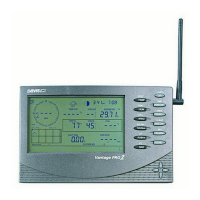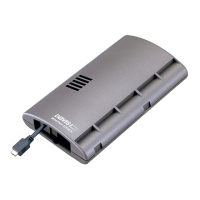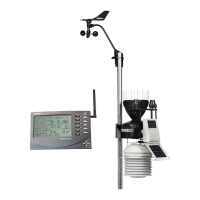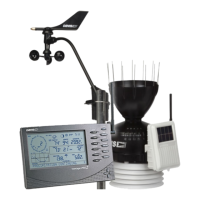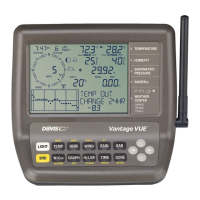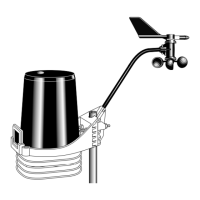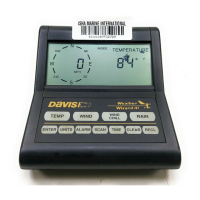Troubleshooting Wireless ISS Reception
11
Note: If the LED is flashing rapidly, call Technical Support. See “Contacting Davis Instruments” on
page 27 for more information.
See “SIM Board Display and Contents” on page 29 for information on locating the
components and points of interest on the SIM board.
5. If the LED remains dark, there is a problem with the ISS transmitter. Call Technical
Support. See “Contacting Davis Instruments” on page 27.
6. If the LED flashes repeatedly but your console isn’t picking up a signal anywhere
in the room, it could be related to one of the following causes:
• You changed the ISS Transmitter ID at the ISS or console, but not at both.
• Reception is being disrupted by frequency interference from outside sources.
Interference has to be strong to prevent the console from receiving a signal
while in the same room as the ISS. In high-interference environments, it may be
preferable to install the Cabled Vantage Pro2.
• There is a problem with the console.
7. If a problem with receiving the wireless transmission still exists, please contact
Technical Support. See “Contacting Davis Instruments” on page 27.
8. When you are finished testing wireless transmission, set DIP switch # 4 to OFF to
take the SIM out of Test Mode.
Note: If the SIM is left in Test Mode, the blinking LED will significantly reduce ISS battery life.
Optional: Changing ISS Transmitter ID
Each wireless transmitting station, including the Integrated Sensor Suite (ISS), uses
one of eight selectable Transmitter IDs. DIP switches #1, 2 and 3 on the transmitter
control the ID — or channel — the station transmits on. DIP switch #4 is used for
transmission testing, not for the Transmitter ID.
Note: The transmitter on the ISS and receiver on the console communicate with each other only when
both are set to the same ID.
The default Transmitter ID is 1 for both the ISS and the Vantage Pro2 console, and
should work fine for most situations. Change the Transmitter ID if any of the
following issues are true:
• Another Davis Instruments wireless weather station operating nearby
already uses Transmitter ID 1.
• Additional Vantage Pro2 or Vantage Vue wireless transmitting stations have
been purchased with the Vantage Pro2 or Vantage Pro2 Plus and one of the
stations has been designated as Station No. 1 instead of the selected ISS.
On the ISS, the Transmitter ID is set using the DIP switches located on the Sensor
Interface Module (SIM). To access the SIM, open the SIM housing cover. See “Open
the SIM Box” on page 5.
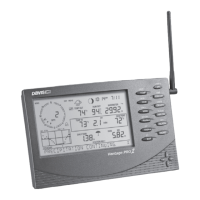
